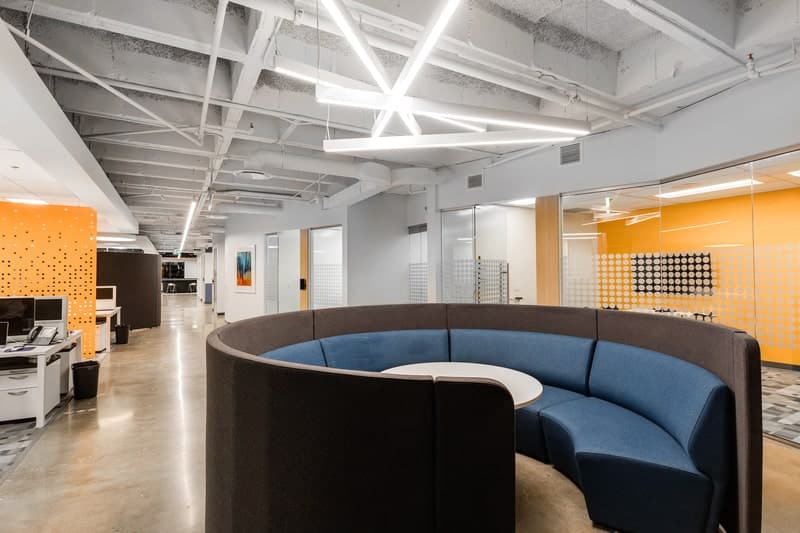Why Your Office Design HAS to Rock
With the shift to work from home in recent years, we’ve all had the opportunity to take a look at how and where we work and how it fits into our lives as a whole. And while employees initially embraced the experience, many are now seeing that the grass isn’t necessarily greener at home. At least not all the time.
As the novelty of at-home work is wearing off, we’re seeing the emergence of “hybrid” models. Many employees feel so strongly about having flexibility that they’re indicating they’d be willing to change jobs to retain the option of balancing their work time between the office and home. They may have Zoom fatigue, but they might not be ready to embrace their commute full-time once again.
While companies are adapting to offer this option, many are also looking for new ways to entice people to come into the office. This is where we come in!
Since we can all agree that most offices are here to stay, the big question is what will they look like? And how they will function at optimal levels? While offices may not be able to include all the advantages of working from home, like wearing comfy clothes or taking the dog for a walk at lunchtime, they can provide the one thing that we’ve been missing: real-life collaboration and camaraderie. The socialization of water cooler banter and face-to-face ideation is important for mental health and engagement, creating a sense of belonging and reinforcing the idea that we are working together for something bigger.
As interior designers, we can help you to re-think your office design to suit the ongoing evolution of work. We need to think bigger. We need to consider what makes working from home appealing and incorporate that into our office spaces. Workplaces have to nurture the culture of the company and the creativity of the people. Offices also need to address employees’ concerns about coming back to an environment where they feel safe.
Safer, More Effective Collaboration
If collaboration and socialization are incentives that make the commute worthwhile, there are several design strategies that can allow for this while giving people the flexibility to feel safe. Larger meeting rooms can be divided into smaller spaces that can be booked for shorter meetings with fewer people. You might even find this increases productivity by spending less time in meetings.
Another idea is to add lots of different styles of seating, so everyone can sit at a more comfortable spot throughout the day, according to the task at hand, whether it’s solo or group work, and what kind of structure will lend itself to that work. From focused, individual desk work with an ergonomic task chair to soft seating areas that facilitate group ideation or client catch-ups.
Hot Desking vs. Dedicated Desks
Apart from that productive cooperative time, employees are always going to need a home base to return to in their desk. Or do they?
With the varying ways that flexible work may take shape, it might make sense to have only some of your team in the office at any time. With rotating schedules, you may choose to move into a reduced office space with fewer desks, but those desks are shared or you could adopt hot desking, where people can book a workstation for a given day and work at a different desk on another day.
Hot desks can be a great option, but it may not be right for every business. For some, it might be important to allow people to have a desk to call their own – their home away from home, so to speak. But maybe they don’t need a full workstation, a semi-private cubicle, or a private office with tons of filing and shelving. They might make do with a simpler height-adjustable desk and a small storage pedestal for personal items.
Either way, it’s important to have solitary spaces that allow employees to complete focused work with no distractions. (Which may be more than they get at home!).
Details to Make Your Office a Destination
Other features and details can make your workplace a destination that people enjoy spending time in as they work. Layered lighting creates a more natural and comfortable feel that keeps people alert. Plants and greenery are not only great for sound absorption and cleaning the air, they make the environment more inviting. You might even want to make allowances for more comfortable clothing styles so people can transition more gradually from their track pants to their business suits.
Elevate some flooring sections to create depth, have bar-style seating or harvest tables. Even if you have to keep six feet apart, you can still feel connected at one large table. Add in some throw rugs.
If you want to be really brave and truly re-think what we have always expected in an office, you can get outside of the box with these ideas: Treadmill desks. TV room. Nap room. As long as they’re used appropriately, these little home-like perks can augment the office work experience, whether you’re all-in or hybrid.
Flexibility isn’t only in the scheduling, it’s also in the office layout. Whether that layout re-think is all you need or you want to engage in a full office redesign, we’re here to help. Give us a call 905-252-0947 or email us design@studioforma.ca

